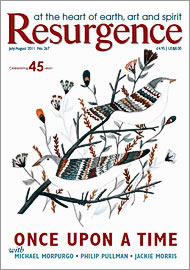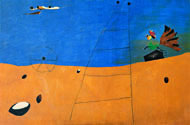This show opens with the joyously assured early rustic paintings Miró made of the family farm and the village of Mont-roig. His seminal painting La Ferme – showing intricately scrutinised details such as a woman washing clothes in the open air (her bizarrely Buddha-like infant squatting nearby), a lizard, a snail and a green watering can on the scorched earth – is described by the Spanish artist as “a résumé of my entire life in the country”. Its hallucinatory detailing owes something both to contemporary experiments in Cubist fragmentation and to the fresh perspectives of children’s art: “No simplifications or abstractions…Right now what interests me is the calligraphy of a tree or a rooftop, leaf by leaf, twig by twig, blade of grass by blade of grass, tile by tile.”
In his revolutionary 1923–4 painting La Terre, Miró jettisoned Arcadian realism in favour of a unique nonsensical vocabulary, evoking surrealistic forms such as a disquietingly prickly dog with phantasmagorical ears, and a tree in whose conical-shaped foliage perches an autonomous, fish-shaped eye.
He went on to invent his own distinctive allusive language in paintings such as Chien abeyant à la lune (‘Dog barking at the moon’) and Paysage au Coq (‘Landscape with Rooster’, opposite). In both works fantastically plaintive creatures are seen barking and crowing at what appear to be eerie other-planetary skies, propped up against which are early versions of his ‘ladders of escape’, mystical symbols of ascent from the terrestrial to celestial spheres of boundless imaginative possibilities.
The exhibition’s extensive picture captions draw attention almost exclusively to the political background and resonances of Miró’s artworks, which is usefully illuminating in as far as it helps trace the artist’s inner and outer states of exile as the Spanish Civil War, the Second World War and Franco’s Spain impinged so forcefully on him and his times. But this emphasis on political repercussions can seem often over-literalistic for an artist whose work is ultimately so enigmatically poetic.
I prefer the more subtle approach taken in the exhibition catalogue when, in referring to Miró’s mid-1930s’ portraits of absurdly spindly, weirdly sexualised ‘personages’ and ‘philosophers’ (seemingly symbolising in part the crude, pompous, malign public figures of the era), it states: “Quite how the diary of imagery reflected Miró’s response to his times is impossible to gauge with certainty, but it is telling that Jacques Dupin has called these works ‘the most precise expression of the artist’s inner world invaded by demons and monsters’.”
Some of the most astonishing works in the show are the Constellations, made in the harsh atmosphere of Paris, just before the threatened Nazi invasion, and three vast Bleu canvases, painted in 1961. The Constellation gouaches and oil washes on paper consist of countless calligraphic forms – redolent of eyes, genitals, stars, moons, cellular forms, birds, kites, flowers and, simply, the unutterable – pulsating dynamically over fluctuating coloured grounds of inner/outer space. These pictures are ambiguously works of creative solace and the most ominous imaginings.
In contrast to these at once elaborately ordered and anarchic visions, the trio of Bleu paintings allows infinite breathing space in which the imagination can soar and explore. Amid serene fields or seas or skies of wonderfully nuanced blues, abstracted black orbs float with Zen-like effortlessness (Miró, who died in 1983, was then exploring areas of Oriental art and philosophy). And at the end of a long, delicate, meandering line, bisecting the blue, soars what could be described as a little red pebble or a numinous oval glowing in the void. No words can really say what trip this tiny red shape has embarked on, but it is one that speaks to the viewer of transcendent awe and delight enjoyed in the free blue spaces of the present moment.








